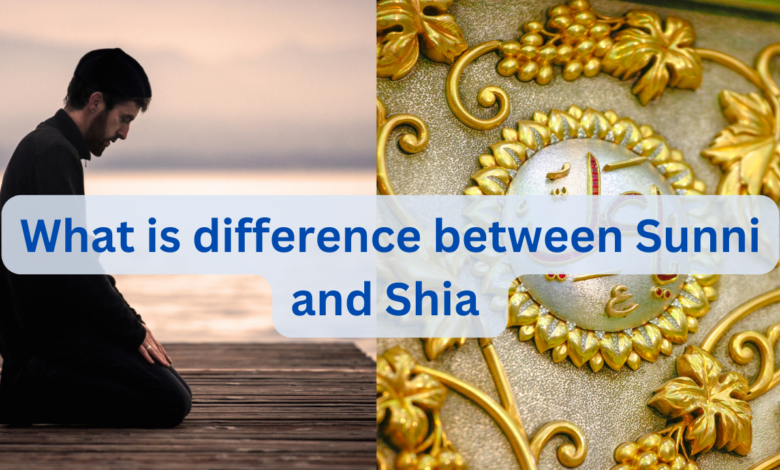What is difference between Sunni and Shia?
Exploring the Sunni-Shia Schism: Origins, Beliefs, and Practices

What is difference between Sunni and Shia?
Sunni and Shia Islam differ primarily in their beliefs about the rightful leadership of the Muslim community after the death of the Prophet Muhammad. Sunnis believe in the leadership of the first four Caliphs, while Shia Muslims follow a line of Imams, starting with Ali, whom they believe were divinely appointed.

Introduction
The division between Sunni and Shia Muslims is one of the most significant and enduring schisms in the Islamic world. While both groups share the fundamental tenets of Islam, they differ in their interpretation of certain historical events and the rightful leadership of the Muslim community. In this article, we will explore the key differences between Sunni and Shia Islam, shedding light on their origins, beliefs, and practices.
Historical Background
The split between Sunni and Shia Muslims can be traced back to the early days of Islam, following the death of the Prophet Muhammad in 632 CE. The primary source of contention centers around the issue of leadership, particularly who should succeed the Prophet as the leader of the Muslim community, or Ummah.
Also check.
- Why Suicide is Haram in Islam
- What is the major sins in Islam
- What are the most important things in Islam?
- When does Ramadan end?
Leadership Dispute
- Sunni Perspective: Sunni Muslims believe in the concept of “Shura,” which means consultation. They maintain that the first four Caliphs (leaders), known as the “Rightly Guided Caliphs” (Rashidun), were chosen through a consensus among the Muslim community. These Caliphs are Abu Bakr, Umar ibn al-Khattab, Uthman ibn Affan, and Ali ibn Abi Talib, in that order. Sunni Islam represents the majority of the Muslim world, with around 85-90% of Muslims adhering to this tradition.
- Shia Perspective: Shia Muslims, on the other hand, believe that leadership should have remained within the family of the Prophet Muhammad. They hold that Ali ibn Abi Talib, the cousin and son-in-law of the Prophet, was the rightful successor, or Imam, and that leadership should have continued within his lineage. Shia Islam is a minority within the Muslim world, comprising approximately 10-15% of the Muslim population.
Imams vs. Caliphs
- Sunni Perspective: Sunnis acknowledge the Caliphs as the leaders of the Muslim community after the Prophet’s death. They emphasize the importance of adherence to the Sunnah (the practices and traditions of the Prophet) and the Hadith (his sayings and actions) as primary sources of guidance in addition to the Quran.
- Shia Perspective: Shia Muslims follow a line of Imams believed to be divinely appointed, starting with Ali and continuing through eleven Imams, with the twelfth Imam believed to be in occultation and will return as a messianic figure. These Imams are seen as infallible and authoritative interpreters of Islamic teachings. Shia Islam also places a strong emphasis on the concept of “Wilayah,” or the spiritual and temporal authority of the Imams.
Religious Practices
Both Sunni and Shia Muslims share common religious practices such as the five pillars of Islam, daily prayers, fasting during Ramadan, and the pilgrimage to Mecca (Hajj). However, there are some differences in how certain religious rituals are performed, including variations in prayer styles, religious holidays, and commemorative events.
Theological Differences
While the theological differences between Sunni and Shia Islam are nuanced and complex, they often relate to concepts of divine justice, predestination, and the role of religious leadership. These theological variations have given rise to distinct schools of thought within each tradition, such as the Hanafi, Maliki, Shafi’i, and Hanbali schools within Sunni Islam, and the Twelver, Ismaili, and Zaidi branches within Shia Islam.
Conclusion
The Sunni-Shia divide is rooted in historical events and differences of opinion regarding leadership and authority in Islam. Despite these differences, it is essential to recognize that Sunni and Shia Muslims both share a profound love for Islam and a commitment to the core principles of the faith. Interactions between Sunni and Shia communities can be marked by cooperation and mutual respect, promoting unity within the diverse Muslim world. Understanding these differences can foster tolerance and dialogue among Muslims and people of all faiths, promoting a more peaceful and harmonious world.
FAQs
What is the difference between Sunni and Shia Islam?
Sunni and Shia Islam differ primarily in their beliefs about the rightful leadership of the Muslim community after the death of the Prophet Muhammad. Sunnis believe in the leadership of the first four Caliphs, while Shia Muslims follow a line of Imams, starting with Ali, whom they believe were divinely appointed.
How did the Sunni-Shia split originate?
The split dates back to the early days of Islam after the death of the Prophet Muhammad. It stemmed from a disagreement over who should lead the Muslim community, with Sunnis supporting the Caliphs and Shia Muslims advocating for the Imams.
Who were the “Rightly Guided Caliphs” in Sunni Islam?
The “Rightly Guided Caliphs” in Sunni Islam were Abu Bakr, Umar ibn al-Khattab, Uthman ibn Affan, and Ali ibn Abi Talib. Sunnis consider them the rightful leaders of the Muslim community after the Prophet’s death.
How many Imams do Shia Muslims follow?
Shia Muslims follow a line of twelve Imams, with Ali ibn Abi Talib being the first and the twelfth Imam believed to be in occultation and expected to return as a messianic figure.
Are there any differences in religious practices between Sunni and Shia Muslims?
While both Sunni and Shia Muslims share core religious practices, there are variations in how certain rituals are performed, such as differences in prayer styles, religious holidays, and commemorative events.
Do Sunni and Shia Muslims have different theological beliefs?
Yes, there are nuanced theological differences between Sunni and Shia Islam, which can relate to concepts of divine justice, predestination, and the role of religious leadership. These differences have given rise to distinct schools of thought within each tradition.
What is the significance of the Sunni-Shia divide in the modern Muslim world?
The Sunni-Shia divide remains a significant aspect of the Islamic world’s cultural and political landscape. It has at times fueled sectarian tensions, but many Muslims from both traditions work towards cooperation and mutual understanding.
Are there efforts to bridge the gap between Sunni and Shia Muslims?
Yes, various interfaith and intrafaith initiatives promote dialogue and cooperation between Sunni and Shia communities. These efforts aim to foster unity and understanding within the diverse Muslim world.
Can a Sunni Muslim marry a Shia Muslim, and vice versa?
Intermarriage between Sunni and Shia Muslims is permissible in Islam, as long as both parties respect each other’s beliefs and practices. Religious compatibility and mutual understanding are essential for a harmonious marriage.
What is the overall message of Islam that both Sunni and Shia Muslims share?
Both Sunni and Shia Muslims share a deep commitment to the core principles of Islam, including the belief in one God (Allah), the importance of prayer, charity, fasting, and pilgrimage, and adherence to the teachings of the Quran and the Prophet Muhammad’s traditions (Sunnah). Despite their differences, these shared beliefs bind Muslims together in faith and practice.



